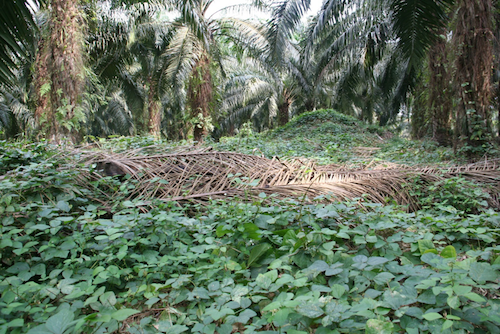Sustainable Oil Palm Farming / Establishing a ground cover
| |
Download: Module 3: Plantation Maintenance
Contents
Goal
Create a closed cover of soft weeds in the plantation to:
- Prevent soil erosion
- Keep the moisture in the soil
- Prevent loss of soil organic matter
- Attract as many natural enemies of pests as possible
- Make access into the plantation easy
- Make weeding fast and easy
Standard
- Good cover of soft weeds everywhere in the inter-row
- Legumes established where possible
- Inter-row weeds slashed at knee height
- No noxious or woody weeds in the plantation
Timing
- At planting, or at the start of the rehabilitation process, after the noxious weeds have been removed
- Not during very strong rain or during the dry period
Frequency
- Establishment of legume cover crop: once in the plantation lifetime
- Maintenance of weed cover: every six months
Labour time required
- Corrective phosphate application: 1 day per hectare
- Sowing legume cover crops or introducing soft weeds: 1—4 hours per hectare, depending on the extent of bare soil
- Slashing of inter-row vegetation: half a day per hectare
Equipment and materials
• Phosphate fertiliser: 500—1000 kg/ha • Fertiliser measuring cup/bucket • Bush knife • Cover plant seeds: usually 1—2 gram per 10 square meters (1—2 kg per hectare)
Who
Farmers and their families or hired labourers
How
Application of phosphate fertilisers
If there are many noxious weeds in the plantation (alang-alang,melastoma, dicranopteris) the soil is likely to be phosphorus-deficient. Beneficial weeds such as ferns and legumes grow better in phosphorus-rich soils.
To help the good weeds grow and reduce the growth of noxious weeds it is useful to apply phosphate fertilisers as follows:
- 500 kg/ha soluble P fertilisers (TSP, SP—36)
- 500—1000 kg/ha reactive rock phosphate
Spread the P fertiliser evenly throughout the plantation, mostly in the inter-row and over the frond stack.
Establishing legume cover plants or other soft weeds
Table 3: List of the most common legume cover crops and some of their properties 5
| Name | Shade tolerance | Sowing practices | Other properties |
|---|---|---|---|
| Calopogonium caeruleum | Very tolerant | Needs scarification | Very productive; tolerant of heavy shade; Figure 14 |
| Mucuna bracteata | Tolerant | Needs to be sown in a seedbed and then planted; benefits from inoculation | Good N fixation; good soil cover; prevents soil erosion |
| Calopogonium mucunoides | Somewhat tolerant | Needs scarification | Pioneer species; short life span |
| Pueraria phaseloides | Somewhat tolerant | Needs scarification | Grows quickly; very palatable for livestock |
Legume cover crops are best sown at the time of land preparation, when all the other weeds have been cleared. If there are many weeds, then the legumes may still grow, but selective weeding will become very difficult. In plantations where clear-weeding was a normal practice, legume cover crops can be sown directly after spraying. For sowing or planting legume cover crops, follow the steps below:
| Step 1. | Select the appropriate legume cover crop (see Table 3). They can also be mixed to increase the chances of successful establishment. |
| Step 2. | Scarify the seeds, if necessary. Scarification is required to remove the hard outside of the seeds, so that the seeds can germinate faster and simultaneously. Scarification can be done mechanically (with sandpaper), by using 70% sulphuric acid or by using hot water 6. The sulphuric acid method is the most common and the most effective one, but the acid may not be widely available and is a dangerous chemical, which is also difficult to dispose of after use. Therefore the mechanical scarification or the hot water treatment are recommended.
For mechanical scarification, use the following approach:
For scarification with hot water, try the following with a small batch of seeds 7:
The optimum temperature and soaking time vary from species to species; if the germination is not good, then it is recommended to try different temperatures and find out what works best |
| Step 3. | Broadcast the seeds in the plantation, on bare soil or in an area that was recently weeded. Start with a small area to see if the legumes are able to establish effectively. |
Apart from sowing legume cover crops, the population of Nephrolepis ferns can also be increased (Figure 15). To achieve this, pull the ferns from the trunks of the palms (roots and all) and throw them in the inter-row. Some of them may establish and start growing. The application of empty fruit bunches promotes the growth of Nephrolepis ferns.
Slashing inter-row vegetation at knee height
- Every six months slash all inter-row vegetation at knee height using a bush knife.
- Note: in some plantations it is considered a good practice to let the ferns in the frond stack area grow over 1 meter tall.
| Date | Time | Location | Activity | Input type | Input amount | Input costs | Labour input | Labour costs | |
| People | Hours | ||||||||
| 16/01/13 | Field 3 | P fertiliser application | Rock phosphate | 1000 kg | 1500000 | 2 | 4 | 80000 | |
| 20/01/13 | Field 3 | Sowing legumes | Legume seed | 2 kg | 400000 | 2 | 4 | 80000 | |
References
- ↑ Tropical Forages, Calopogonium caeruleum, http://www.tropicalforages.info/key/Forages/Media/Html/Calopogonium_caeruleum.htm, Accessed September 2013.
- ↑ Tropical Forages, Calopogonium mucunoides, http://www.tropicalforages.info/key/Forages/Media/Html/Calopogonium_mucunoides.htm, Accessed September 2013.
- ↑ Tropical Forages, Pueraria phaseoloides, http://www.tropicalforages.info/key/Forages/Media/Html/Pueraria_phaseoloides.htm, Accessed September 2013.
- ↑ Covercrops.org, 2014, Mucuna bracteata, Nadampadom Rubber Estate, Kerala, India, http://www.covercrops.org/mucunabracteata.php, Accessed September 2013.
- ↑ Sime Darby, Leguminous Cover Crop Seeds, Sime Darby Agro-Bio Sdn Bhd, Subang Jaya, Malaysia
- ↑ P.J. Argel, C.J. Paton, Overcoming legume hardseededness, in: Forage Seed Production, Volume 2, CABI Publishing, Wallingford, 1999, pp. 247—265.
- ↑ I.F. Hanum, L.J.G. Van der Maesen, PROSEA: Plant Resources of South-East Asia 11, Auxiliary Plants, Prosea Foundation, Bogor, Indonesia, 1997.
Acknowledgements
The material from Establishing a ground cover is sourced from Smallholder Oil Palm Handbook and put together by Lotte Suzanne Woittiez (Wageningen Universit) and Haryono Sadikin, Sri Turhina, Hidayat Dani, Tri Purba Dukan, and Hans Smit (SNV) in August 2016. See Module 3: Plantation Maintenance for more information.





